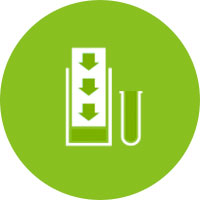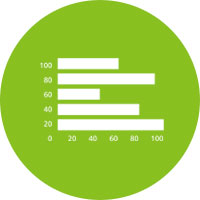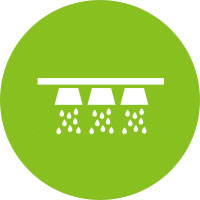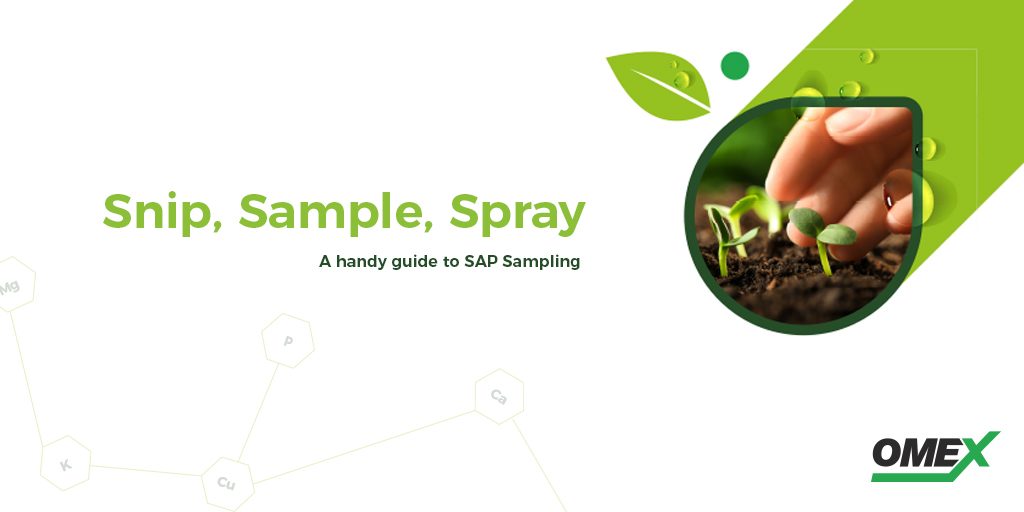Snip, Sample, Spray
Every season comes with it's own set of crop stress related hurdles - too much rain, too little rain! Knowing how your plant is coping during times of stress, will be vital this Spring, so you can be sure of exactly what your crop needs to flourish.
Sustainably producing food requires accurate monitoring of the crops nutrient levels, so nutrients aren't over or under applied. SAP Analysis offers a highly accurate and topical assessment of the true nutritional status of the plant. Whereas conventional tissue testing reports the level of nutrients in a sample, including those locked up and unavailable for growth in cell walls and storage cells, SAP analysis measures only the actual level of crop nutrients available for plant growth.
Here's our simple 5 step guide, for accurate nutrient sampling this Spring, with SAP Analysis:
 SAP sampling procedures are crop specific. Full details and sampling instruction are supplied in your dedicated 'SAP Pack'. You can sample when problems are seen, when the crop is under stress, or prior to a growth surge.
You should take your sample in a representative manner, either in a pre-marked "W" or in a straight line and select the oldest actively growing leaf from at least 20 plants.
Contact our Crop Nutrition Agronomist, Scott Baker, for more information and to get your SAP Pack.
SAP sampling procedures are crop specific. Full details and sampling instruction are supplied in your dedicated 'SAP Pack'. You can sample when problems are seen, when the crop is under stress, or prior to a growth surge.
You should take your sample in a representative manner, either in a pre-marked "W" or in a straight line and select the oldest actively growing leaf from at least 20 plants.
Contact our Crop Nutrition Agronomist, Scott Baker, for more information and to get your SAP Pack.
 Once we've received your sample our expert lab and research team prepare the samples for testing using the facilities of the Scientific Agricultural Partnership (SAP®) laboratories in King’s Lynn.
The laboratories specialise in the extraction, analysis and interpretation of sap samples taken from growing plants.
Once we've received your sample our expert lab and research team prepare the samples for testing using the facilities of the Scientific Agricultural Partnership (SAP®) laboratories in King’s Lynn.
The laboratories specialise in the extraction, analysis and interpretation of sap samples taken from growing plants.
 The sample is then analysed to show 17 different nutrient levels including: No3, NH4, P, K, Mg, S, Ca, Na, Cl, Mn, B, Cu, Fe, Zn, Mo, Al, and pH
The sample is then analysed to show 17 different nutrient levels including: No3, NH4, P, K, Mg, S, Ca, Na, Cl, Mn, B, Cu, Fe, Zn, Mo, Al, and pH
 The results from the sample are then assessed by our team of FACTS qualified agronomists who provide the farmer with an easy to interpret bar chart, alongside agronomist comments. These recommendations are emailed within 2-3 days of receipt of the samples.
The results from the sample are then assessed by our team of FACTS qualified agronomists who provide the farmer with an easy to interpret bar chart, alongside agronomist comments. These recommendations are emailed within 2-3 days of receipt of the samples.
 With rapid turnaround sample results, alongside dedicated Crop Nutrition Agronomists comments, you can apply exactly what your crop needs this Spring.
With rapid turnaround sample results, alongside dedicated Crop Nutrition Agronomists comments, you can apply exactly what your crop needs this Spring.
Step 1: Take the sample
 SAP sampling procedures are crop specific. Full details and sampling instruction are supplied in your dedicated 'SAP Pack'. You can sample when problems are seen, when the crop is under stress, or prior to a growth surge.
You should take your sample in a representative manner, either in a pre-marked "W" or in a straight line and select the oldest actively growing leaf from at least 20 plants.
Contact our Crop Nutrition Agronomist, Scott Baker, for more information and to get your SAP Pack.
SAP sampling procedures are crop specific. Full details and sampling instruction are supplied in your dedicated 'SAP Pack'. You can sample when problems are seen, when the crop is under stress, or prior to a growth surge.
You should take your sample in a representative manner, either in a pre-marked "W" or in a straight line and select the oldest actively growing leaf from at least 20 plants.
Contact our Crop Nutrition Agronomist, Scott Baker, for more information and to get your SAP Pack.
Step 2: Preparation
 Once we've received your sample our expert lab and research team prepare the samples for testing using the facilities of the Scientific Agricultural Partnership (SAP®) laboratories in King’s Lynn.
The laboratories specialise in the extraction, analysis and interpretation of sap samples taken from growing plants.
Once we've received your sample our expert lab and research team prepare the samples for testing using the facilities of the Scientific Agricultural Partnership (SAP®) laboratories in King’s Lynn.
The laboratories specialise in the extraction, analysis and interpretation of sap samples taken from growing plants.
Step 3: Analysis
 The sample is then analysed to show 17 different nutrient levels including: No3, NH4, P, K, Mg, S, Ca, Na, Cl, Mn, B, Cu, Fe, Zn, Mo, Al, and pH
The sample is then analysed to show 17 different nutrient levels including: No3, NH4, P, K, Mg, S, Ca, Na, Cl, Mn, B, Cu, Fe, Zn, Mo, Al, and pH
Step 4: Results
 The results from the sample are then assessed by our team of FACTS qualified agronomists who provide the farmer with an easy to interpret bar chart, alongside agronomist comments. These recommendations are emailed within 2-3 days of receipt of the samples.
The results from the sample are then assessed by our team of FACTS qualified agronomists who provide the farmer with an easy to interpret bar chart, alongside agronomist comments. These recommendations are emailed within 2-3 days of receipt of the samples.
Step 5: Application
 With rapid turnaround sample results, alongside dedicated Crop Nutrition Agronomists comments, you can apply exactly what your crop needs this Spring.
With rapid turnaround sample results, alongside dedicated Crop Nutrition Agronomists comments, you can apply exactly what your crop needs this Spring. 